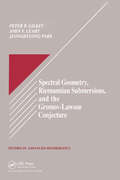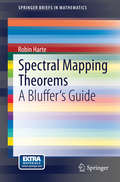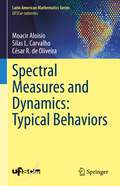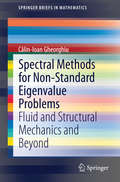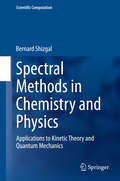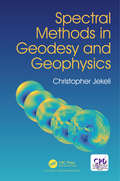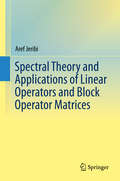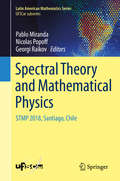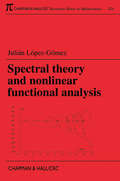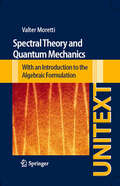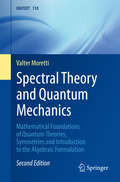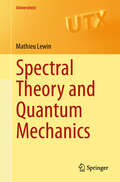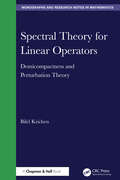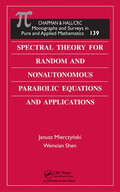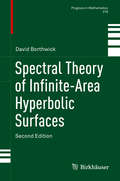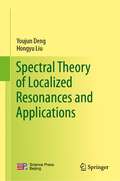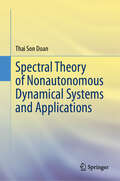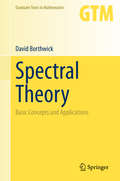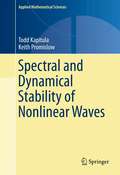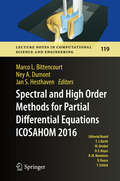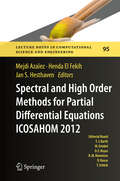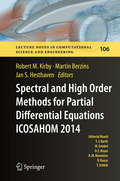- Table View
- List View
Spectral Geometry, Riemannian Submersions, and the Gromov-Lawson Conjecture (Studies in Advanced Mathematics)
by Peter B. Gilkey JeongHyeong Park John V. LeahyThis cutting-edge, standard-setting text explores the spectral geometry of Riemannian submersions. Working for the most part with the form valued Laplacian in the class of smooth compact manifolds without boundary, the authors study the relationship-if any-between the spectrum of Dp on Y and Dp on Z, given that Dp is the p form valued Laplacian and pi: Z (R) Y is a Riemannian submersion.After providing the necessary background, including basic differential geometry and a discussion of Laplace type operators, the authors address rigidity theorems. They establish conditions that ensure that the pull back of every eigenform on Y is an eigenform on Z so the eigenvalues do not change, then show that if a single eigensection is preserved, the eigenvalues do not change for the scalar or Bochner Laplacians. For the form valued Laplacian, they show that if an eigenform is preserved, then the corresponding eigenvalue can only increase. They generalize these results to the complex setting as well. However, the spinor setting is quite different. For a manifold with non-trivial boundary and imposed Neumann boundary conditions, the result is surprising-the eigenvalues can change.Although this is a relatively rare phenomenon, the authors give examples-a circle bundle or, more generally, a principal bundle with structure group G where the first cohomology group H1(G;R) is non trivial. They show similar results in the complex setting, show that eigenvalues can decrease in the spinor setting, and offer a list of unsolved problems in this area.Moving to some related topics involving questions of positive curvature, for the first time in mathematical literature the authors establish a link between the spectral geometry of Riemannian submersions and the Gromov-Lawson conjecture.Spectral Geometry, Riemannian Submersions, and the Gromov-Lawson Conjecture addresses a hot research area and promises to set a standard for the field. Researchers and applied mathematicians interested in mathematical physics and relativity will find this work both fascinating and important.
Spectral Mapping Theorems
by Robin HarteWritten by an author who was at the forefront of developments in multi-variable spectral theory during the seventies and the eighties, this guide sets out to describe in detail the spectral mapping theorem in one, several and many variables. The basic algebraic systems - semigroups, rings and linear algebras - are summarised, and then topological-algebraic systems, including Banach algebras, to set up the basic language of algebra and analysis. Spectral Mapping Theorems is written in an easy-to-read and engaging manner and will be useful for both the beginner and expert. It will be of great importance to researchers and postgraduates studying spectral theory.
Spectral Measures and Dynamics: Typical Behaviors (Latin American Mathematics Series)
by César R. de Oliveira Moacir Aloisio Silas L. CarvalhoThis book convenes and deepens generic results about spectral measures, many of them available so far in scattered literature. It starts with classic topics such as Wiener lemma, Strichartz inequality, and the basics of fractal dimensions of measures, progressing to more advanced material, some of them developed by the own authors.A fundamental concept to the mathematical theory of quantum mechanics, the spectral measure relates to the components of the quantum state concerning the energy levels of the Hamiltonian operator and, on the other hand, to the dynamics of such state. However, these correspondences are not immediate, with many nuances and subtleties discovered in recent years.A valuable example of such subtleties is found in the so-called “Wonderland theorem” first published by B. Simon in 1995. It shows that, for some metric space of self-adjoint operators, the set of operators whose spectral measures are singular continuous is a generic set (which, for some, is exotic). Recent works have revealed that, on top of singular continuity, there are other generic properties of spectral measures. These properties are usually associated with a number of different notions of generalized dimensions, upper and lower dimensions, with dynamical implications in quantum mechanics, ergodicity of dynamical systems, and evolution semigroups. All this opens ways to new and instigating avenues of research.Graduate students with a specific interest in the spectral properties of spectral measure are the primary target audience for this work, while researchers benefit from a selection of important results, many of them presented in the book format for the first time.
Spectral Methods Using Multivariate Polynomials On The Unit Ball (Chapman & Hall/CRC Monographs and Research Notes in Mathematics)
by Kendall Atkinson Olaf Hansen David ChienSpectral Methods Using Multivariate Polynomials on the Unit Ball is a research level text on a numerical method for the solution of partial differential equations. The authors introduce, illustrate with examples, and analyze 'spectral methods' that are based on multivariate polynomial approximations. The method presented is an alternative to finite element and difference methods for regions that are diffeomorphic to the unit disk, in two dimensions, and the unit ball, in three dimensions. The speed of convergence of spectral methods is usually much higher than that of finite element or finite difference methods. Features Introduces the use of multivariate polynomials for the construction and analysis of spectral methods for linear and nonlinear boundary value problems Suitable for researchers and students in numerical analysis of PDEs, along with anyone interested in applying this method to a particular physical problem One of the few texts to address this area using multivariate orthogonal polynomials, rather than tensor products of univariate polynomials.
Spectral Methods for Non-Standard Eigenvalue Problems
by Călin-Ioan GheorghiuThis book focuses on the constructive and practical aspects of spectral methods. It rigorously examines the most important qualities as well as drawbacks of spectral methods in the context of numerical methods devoted to solve non-standard eigenvalue problems. In addition, the book also considers some nonlinear singularly perturbed boundary value problems along with eigenproblems obtained by their linearization around constant solutions. The book is mathematical, poising problems in their proper function spaces, but its emphasis is on algorithms and practical difficulties. The range of applications is quite large. High order eigenvalue problems are frequently beset with numerical ill conditioning problems. The book describes a wide variety of successful modifications to standard algorithms that greatly mitigate these problems. In addition, the book makes heavy use of the concept of pseudospectrum, which is highly relevant to understanding when disaster is imminent in solving eigenvalue problems. It also envisions two classes of applications, the stability of some elastic structures and the hydrodynamic stability of some parallel shear flows. This book is an ideal reference text for professionals (researchers) in applied mathematics, computational physics and engineering. It will be very useful to numerically sophisticated engineers, physicists and chemists. The book can also be used as a textbook in review courses such as numerical analysis, computational methods in various engineering branches or physics and computational methods in analysis.
Spectral Methods in Chemistry and Physics
by Bernard ShizgalThis book is a pedagogical presentation of the application of spectral and pseudospectral methods to kinetic theory and quantum mechanics. There are additional applications to astrophysics, engineering, biology and many other fields. The main objective of this book is to provide the basic concepts to enable the use of spectral and pseudospectral methods to solve problems in diverse fields of interest and to a wide audience. While spectral methods are generally based on Fourier Series or Chebychev polynomials, non-classical polynomials and associated quadratures are used for many of the applications presented in the book. Fourier series methods are summarized with a discussion of the resolution of the Gibbs phenomenon. Classical and non-classical quadratures are used for the evaluation of integrals in reaction dynamics including nuclear fusion, radial integrals in density functional theory, in elastic scattering theory and other applications. The subject matter includes the calculation of transport coefficients in gases and other gas dynamical problems based on spectral and pseudospectral solutions of the Boltzmann equation. Radiative transfer in astrophysics and atmospheric science, and applications to space physics are discussed. The relaxation of initial non-equilibrium distributions to equilibrium for several different systems is studied with the Boltzmann and Fokker-Planck equations. The eigenvalue spectra of the linear operators in the Boltzmann, Fokker-Planck and Schrödinger equations are studied with spectral and pseudospectral methods based on non-classical orthogonal polynomials. The numerical methods referred to as the Discrete Ordinate Method, Differential Quadrature, the Quadrature Discretization Method, the Discrete Variable Representation, the Lagrange Mesh Method, and others are discussed and compared. MATLAB codes are provided for most of the numerical results reported in the book - see Link under 'Additional Information' on the the right-hand column.
Spectral Methods in Geodesy and Geophysics
by Christopher JekeliThe text develops the principal aspects of applied Fourier analysis and methodology with the main goal to inculcate a different way of perceiving global and regional geodetic and geophysical data, namely from the perspective of the frequency, or spectral, domain rather than the spatial domain. The word "methods" in the title is meant to convey that the transformation of a geophysical signal into the spectral domain can be applied for purposes of analysis as well as rapid computation. The text is written for graduate students; however, Chapters 1 through 4 and parts of 5 can also benefit undergraduates who have a solid and fluent knowledge of integral and differential calculus, have some statistical background, and are not uncomfortable with complex numbers. Concepts are developed by starting from the one-dimensional domain and working up to the spherical domain, which is part of every chapter. Many concepts are illustrated graphically with actual geophysical data primarily from signals of gravity, magnetism, and topography.
Spectral Spaces (New Mathematical Monographs #35)
by Max Dickmann Niels Schwartz Marcus TresslSpectral spaces are a class of topological spaces. They are a tool linking algebraic structures, in a very wide sense, with geometry. They were invented to give a functional representation of Boolean algebras and distributive lattices and subsequently gained great prominence as a consequence of Grothendieck's invention of schemes. There are more than 1,000 research articles about spectral spaces, but this is the first monograph. It provides an introduction to the subject and is a unified treatment of results scattered across the literature, filling in gaps and showing the connections between different results. The book includes new research going beyond the existing literature, answering questions that naturally arise from this comprehensive approach. The authors serve graduates by starting gently with the basics. For experts, they lead them to the frontiers of current research, making this book a valuable reference source.
Spectral Theory and Applications of Linear Operators and Block Operator Matrices
by Aref JeribiExamining recent mathematical developments in the study of Fredholm operators, spectral theory and block operator matrices, with a rigorous treatment of classical Riesz theory of polynomially-compact operators, this volume covers both abstract and applied developments in the study of spectral theory. These topics are intimately related to the stability of underlying physical systems and play a crucial role in many branches of mathematics as well as numerous interdisciplinary applications. By studying classical Riesz theory of polynomially compact operators in order to establish the existence results of the second kind operator equations, this volume will assist the reader working to describe the spectrum, multiplicities and localization of the eigenvalues of polynomially-compact operators.
Spectral Theory and Mathematical Physics: STMP 2018, Santiago, Chile (Latin American Mathematics Series #254)
by Georgi Raikov Pablo Miranda Nicolas PopoffThis proceedings volume contains peer-reviewed, selected papers and surveys presented at the conference Spectral Theory and Mathematical Physics (STMP) 2018 which was held in Santiago, Chile, at the Pontifical Catholic University of Chile in December 2018. The original works gathered in this volume reveal the state of the art in the area and reflect the intense cooperation between young researchers in spectral theoryand mathematical physics and established specialists in this field. The list of topics covered includes: eigenvalues and resonances for quantum Hamiltonians; spectral shift function and quantum scattering; spectral properties of random operators; magnetic quantum Hamiltonians; microlocal analysis and its applications in mathematical physics. This volume can be of interest both to senior researchers and graduate students pursuing new research topics in Mathematical Physics.
Spectral Theory and Nonlinear Functional Analysis (Chapman & Hall/CRC Research Notes in Mathematics Series)
by Julian Lopez-GomezThis Research Note addresses several pivotal problems in spectral theory and nonlinear functional analysis in connection with the analysis of the structure set of zeroes of a general class of nonlinear operators. Appealing to a broad audience, it contains many important contributions to linear algebra, linear functional analysis, nonlinear functional analysis, and topology. The author gives several applications of the abstract theory to reaction diffusion equations and systems. The results presented cover a thirty-year period and cut across a variety of mathematical fields.
Spectral Theory and Quantum Mechanics
by Valter MorettiThis book pursues the accurate study of the mathematical foundations of Quantum Theories. It may be considered an introductory text on linear functional analysis with a focus on Hilbert spaces. Specific attention is given to spectral theory features that are relevant in physics. Having left the physical phenomenology in the background, it is the formal and logical aspects of the theory that are privileged. Another not lesser purpose is to collect in one place a number of useful rigorous statements on the mathematical structure of Quantum Mechanics, including some elementary, yet fundamental, results on the Algebraic Formulation of Quantum Theories. In the attempt to reach out to Master's or PhD students, both in physics and mathematics, the material is designed to be self-contained: it includes a summary of point-set topology and abstract measure theory, together with an appendix on differential geometry. The book should benefit established researchers to organise and present the profusion of advanced material disseminated in the literature. Most chapters are accompanied by exercises, many of which are solved explicitly.
Spectral Theory and Quantum Mechanics
by Valter MorettiThis book pursues the accurate study of the mathematical foundations of Quantum Theories. It may be considered an introductory text on linear functional analysis with a focus on Hilbert spaces. Specific attention is given to spectral theory features that are relevant in physics. Having left the physical phenomenology in the background, it is the formal and logical aspects of the theory that are privileged. Another not lesser purpose is to collect in one place a number of useful rigorous statements on the mathematical structure of Quantum Mechanics, including some elementary, yet fundamental, results on the Algebraic Formulation of Quantum Theories. In the attempt to reach out to Master's or PhD students, both in physics and mathematics, the material is designed to be self-contained: it includes a summary of point-set topology and abstract measure theory, together with an appendix on differential geometry. The book should benefit established researchers to organise and present the profusion of advanced material disseminated in the literature. Most chapters are accompanied by exercises, many of which are solved explicitly.
Spectral Theory and Quantum Mechanics (Universitext)
by Mathieu LewinThis textbook presents the spectral theory of self-adjoint operators on Hilbert space and its applications in quantum mechanics. Based on a course taught by the author in Paris, the book not only covers the mathematical theory but also provides its physical interpretation, offering an accessible introduction to quantum mechanics for students with a background in mathematics. The presentation incorporates numerous physical examples to illustrate the abstract theory. The final two chapters present recent findings on Schrödinger’s equation for systems of particles. While primarily designed for graduate courses, the book can also serve as a valuable introduction to the subject for more advanced readers. It requires no prior knowledge of physics, assuming only a graduate-level understanding of mathematical analysis from the reader.
Spectral Theory and its Applications
by Bernard HelfferBernard Helffer's graduate-level introduction to the basic tools in spectral analysis is illustrated by numerous examples from the Schrödinger operator theory and various branches of physics: statistical mechanics, superconductivity, fluid mechanics and kinetic theory. The later chapters also introduce non self-adjoint operator theory with an emphasis on the role of the pseudospectra. The author's focus on applications, along with exercises and examples, enables readers to connect theory with practice so that they develop a good understanding of how the abstract spectral theory can be applied. The final chapter provides various problems that have been the subject of active research in recent years and will challenge the reader's understanding of the material covered.
Spectral Theory for Linear Operators: Demicompactness and Perturbation Theory (Chapman & Hall/CRC Monographs and Research Notes in Mathematics)
by Bilel KrichenThis book focuses on spectral theory for linear operators involving bounded or unbounded demicompact linear operators acting on Banach spaces. This class played an important rule in the theory of perturbation. More precisely, it contributed in the construction of several classes of stability of essential spectra for bounded or unbounded linear operators. We should emphasize that this book is the first one dealing with the demicompactness concept and its relation with Fredholm theory for bounded and unbounded linear operators as well as block operator matrices acting on Banach spaces. Researchers, as well as graduate students in applicable analysis, will find that this book constitutes a useful survey of the fundamental principles of the subject. Nevertheless, the reader is assumed to be, at least, familiar with some related sections concerning notions like the compact, Fredholm operators, the basic tools of the weak topology, the concept of measures of weak noncompactness, etc. Otherwise, the reader is urged to consult the recommended literature in order to benefit fully from this book.Features -• First book dealing with demicompactness theory and its relation with Fredholm theory for bounded and unbounded linear operators as well as block operator matrices acting on Banach spaces.• Self-contained coverage of classical and more recent classes of perturbations involving the concept of demicompactness.• Offers a useful survey of the fundamental principles of spectral theory.• Provides applications for problem arising in physics and which are modeled by integral or partial differential equations.
Spectral Theory for Random and Nonautonomous Parabolic Equations and Applications (Monographs and Surveys in Pure and Applied Mathematics)
by Janusz Mierczynski Wenxian ShenProviding a basic tool for studying nonlinear problems, Spectral Theory for Random and Nonautonomous Parabolic Equations and Applications focuses on the principal spectral theory for general time-dependent and random parabolic equations and systems. The text contains many new results and considers existing results from a fresh perspective.
Spectral Theory of Infinite-Area Hyperbolic Surfaces
by David BorthwickThis text introduces geometric spectral theory in the context of infinite-area Riemann surfaces, providing a comprehensive account of the most recent developments in the field. For the second edition the context has been extended to general surfaces with hyperbolic ends, which provides a natural setting for development of the spectral theory while still keeping technical difficulties to a minimum. All of the material from the first edition is included and updated, and new sections have been added. Topics covered include an introduction to the geometry of hyperbolic surfaces, analysis of the resolvent of the Laplacian, scattering theory, resonances and scattering poles, the Selberg zeta function, the Poisson formula, distribution of resonances, the inverse scattering problem, Patterson-Sullivan theory, and the dynamical approach to the zeta function. The new sections cover the latest developments in the field, including the spectral gap, resonance asymptotics near the critical line, and sharp geometric constants for resonance bounds. A new chapter introduces recently developed techniques for resonance calculation that illuminate the existing results and conjectures on resonance distribution. The spectral theory of hyperbolic surfaces is a point of intersection for a great variety of areas, including quantum physics, discrete groups, differential geometry, number theory, complex analysis, and ergodic theory. This book will serve as a valuable resource for graduate students and researchers from these and other related fields. Review of the first edition: "The exposition is very clear and thorough, and essentially self-contained; the proofs are detailed. . . The book gathers together some material which is not always easily available in the literature. . . To conclude, the book is certainly at a level accessible to graduate students and researchers from a rather large range of fields. Clearly, the reader. . . would certainly benefit greatly from it. " (Colin Guillarmou, Mathematical Reviews, Issue 2008 h)
Spectral Theory of Localized Resonances and Applications
by Hongyu Liu Youjun DengThis book is devoted to the spectral theory of localized resonances including surface plasmon/polariton resonances, atypical resonances, anomalous localized resonances and interior transmission resonances. Those resonance phenomena arise in different physical contexts, but share similar features. They form the fundamental basis for many cutting-edge technologies and applications including invisibility cloaking and super-resolution imaging. The book presents a systematic and comprehensive treatment on these resonance phenomena and the associated applications in a unified manner from a mathematical and spectral perspective, covering acoustic, electromagnetic and elastic wave scattering.The book can serve as a handy reference book for researchers in this field and it can also serve as a textbook or an inspiring source for postgraduate students who are interested in entering this field.
Spectral Theory of Nonautonomous Dynamical Systems and Applications
by Thai Son DoanThe main challenge in the study of nonautonomous phenomena is to understand the very complicated dynamical behaviour both as a scientific and mathematical problem. The theory of nonautonomous dynamical systems has experienced a renewed and steadily growing interest in the last twenty years, stimulated also by synergetic effects of disciplines which have developed relatively independent for some time such as topological skew product, random dynamical systems, finite-time dynamics and control systems. The book provides new insights in many aspects of the qualitative theory of nonautonomous dynamical systems including the spectral theory, the linearization theory, the bifurcation theory. The book first introduces several important spectral theorem for nonautonomous differential equations including the Lyapunov spectrum, Sacker-Sell spectrum and finite-time spectrum. The author also establishes the smooth linearization and partial linearization for nonautonomous differential equations in application part. Then the second part recalls the multiplicative ergodic theorem for random dynamical systems and discusses several explicit formulas in computing the Lyapunov spectrum for random dynamical systems generated by linear stochastic differential equations and random difference equations with random delay. In the end, the Pitchfork bifurcation and Hopf bifurcation with additive noise are investigated in terms of change of the sign of Lyapunov exponents and loss of topological equivalence. This book might be appealing to researchers and graduate students in the field of dynamical systems, stochastic differential equations, ergodic theory.
Spectral Theory: Basic Concepts and Applications (Graduate Texts in Mathematics #284)
by David BorthwickThis textbook offers a concise introduction to spectral theory, designed for newcomers to functional analysis. Curating the content carefully, the author builds to a proof of the spectral theorem in the early part of the book. Subsequent chapters illustrate a variety of application areas, exploring key examples in detail. Readers looking to delve further into specialized topics will find ample references to classic and recent literature. Beginning with a brief introduction to functional analysis, the text focuses on unbounded operators and separable Hilbert spaces as the essential tools needed for the subsequent theory. A thorough discussion of the concepts of spectrum and resolvent follows, leading to a complete proof of the spectral theorem for unbounded self-adjoint operators. Applications of spectral theory to differential operators comprise the remaining four chapters. These chapters introduce the Dirichlet Laplacian operator, Schrödinger operators, operators on graphs, and the spectral theory of Riemannian manifolds. Spectral Theory offers a uniquely accessible introduction to ideas that invite further study in any number of different directions. A background in real and complex analysis is assumed; the author presents the requisite tools from functional analysis within the text. This introductory treatment would suit a functional analysis course intended as a pathway to linear PDE theory. Independent later chapters allow for flexibility in selecting applications to suit specific interests within a one-semester course.
Spectral and Dynamical Stability of Nonlinear Waves
by Keith Promislow Todd KapitulaThis book unifies the dynamical systems and functional analysis approaches to the linear and nonlinear stability of waves. It synthesizes fundamental ideas of the past 20+ years of research, carefully balancing theory and application. The book isolates and methodically develops key ideas by working through illustrative examples that are subsequently synthesized into general principles. Many of the seminal examples of stability theory, including orbital stability of the KdV solitary wave, and asymptotic stability of viscous shocks for scalar conservation laws, are treated in a textbook fashion for the first time. It presents spectral theory from a dynamical systems and functional analytic point of view, including essential and absolute spectra, and develops general nonlinear stability results for dissipative and Hamiltonian systems. The structure of the linear eigenvalue problem for Hamiltonian systems is carefully developed, including the Krein signature and related stability indices. The Evans function for the detection of point spectra is carefully developed through a series of frameworks of increasing complexity. Applications of the Evans function to the Orientation index, edge bifurcations, and large domain limits are developed through illustrative examples. The book is intended for first or second year graduate students in mathematics, or those with equivalent mathematical maturity. It is highly illustrated and there are many exercises scattered throughout the text that highlight and emphasize the key concepts. Upon completion of the book, the reader will be in an excellent position to understand and contribute to current research in nonlinear stability.
Spectral and High Order Methods for Partial Differential Equations ICOSAHOM 2016
by Jan S. Hesthaven Marco L. Bittencourt Ney A. DumontThis book features a selection of high-quality papers chosen from the best presentations at the International Conference on Spectral and High-Order Methods (2016), offering an overview of the depth and breadth of the activities within this important research area. The carefully reviewed papers provide a snapshot of the state of the art, while the extensive bibliography helps initiate new research directions.
Spectral and High Order Methods for Partial Differential Equations - ICOSAHOM 2012
by Jan S. Hesthaven Mejdi Azaïez Henda El FekihThe book contains a selection of high quality papers, chosen among the best presentations during the International Conference on Spectral and High-Order Methods (2012), and provides an overview of the depth and breath of the activities within this important research area. The carefully reviewed selection of the papers will provide the reader with a snapshot of state-of-the-art and help initiate new research directions through the extensive bibliography.
Spectral and High Order Methods for Partial Differential Equations ICOSAHOM 2014
by Jan S. Hesthaven Robert M. Kirby Martin BerzinsThe book contains a selection of high quality papers, chosen among the best presentations during the International Conference on Spectral and High-Order Methods (2014), and provides an overview of the depth and breadth of the activities within this important research area. The carefully reviewed selection of papers will provide the reader with a snapshot of the state-of-the-art and help initiate new research directions through the extensive biography.
